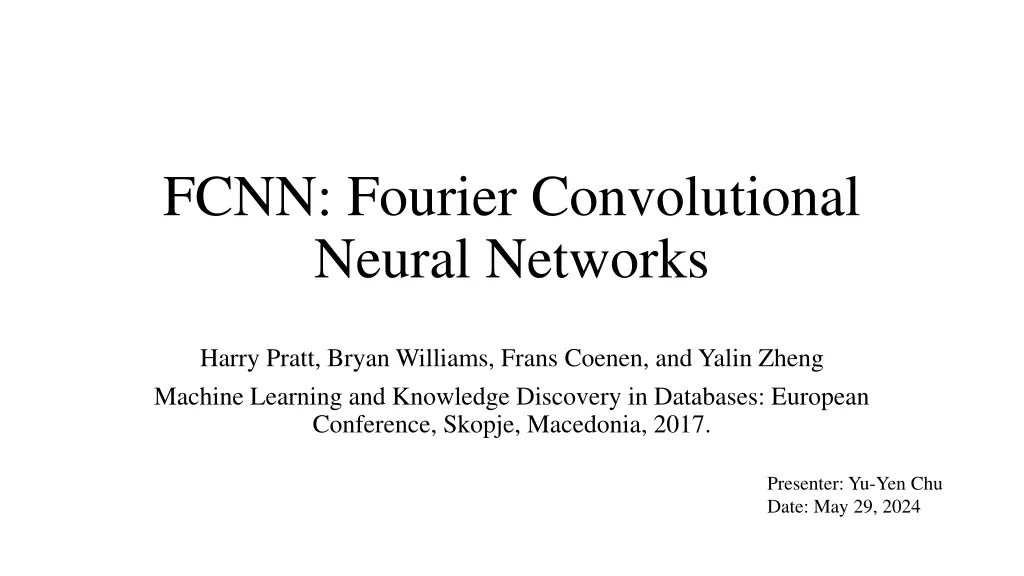
Fourier Convolutional Neural Networks: Improving Image Analysis Efficiency
Explore how Fourier domain techniques enhance image analysis efficiency with Fourier Convolutional Neural Networks (FCNN). Learn how FCNN accelerates training time while maintaining accuracy, making it suitable for large image tasks. Discover the potential of FCNN to enhance convolution in neural network systems.
Download Presentation

Please find below an Image/Link to download the presentation.
The content on the website is provided AS IS for your information and personal use only. It may not be sold, licensed, or shared on other websites without obtaining consent from the author. If you encounter any issues during the download, it is possible that the publisher has removed the file from their server.
You are allowed to download the files provided on this website for personal or commercial use, subject to the condition that they are used lawfully. All files are the property of their respective owners.
The content on the website is provided AS IS for your information and personal use only. It may not be sold, licensed, or shared on other websites without obtaining consent from the author.
E N D
Presentation Transcript
FCNN: Fourier Convolutional Neural Networks Harry Pratt, Bryan Williams, Frans Coenen, and Yalin Zheng Machine Learning and Knowledge Discovery in Databases: European Conference, Skopje, Macedonia, 2017. Presenter: Yu-Yen Chu Date: May 29, 2024
Abstract The Fourier domain is used in computer vision and machine learning as image analysis tasks in the Fourier domain are analogous to spatial domain methods but are achieved using different operations. Convolutional Neural Networks (CNNs) use machine learning to achieve state-of-the-art results with respect to many computer vision tasks. One of the main limiting aspects of CNNs is the computational cost of updating a large number of convolution parameters. Further, in the spatial domain, larger images take exponentially longer than smaller image to train on CNNs due to the operations involved in convolution methods. Consequently, CNNs are often not a viable solution for large image computer vision tasks. 2
Abstract (Cont.) In this paper a Fourier Convolution Neural Network (FCNN) is proposed whereby training is conducted entirely within the Fourier domain. The advantage offered is that there is a significant speed up in training time without loss of effectiveness. Using the proposed approach larger images can therefore be processed within viable computation time. The FCNN is fully described and evaluated. The evaluation was conducted using the benchmark Cifar10 and MNIST datasets, and a bespoke fundus retina image dataset. The results demonstrate that convolution in the Fourier domain gives a significant speed up without adversely affecting accuracy. For simplicity the proposed FCNN concept is presented in the context of a basic CNN architecture, however, the FCNN concept has the potential to improve the speed of any neural network system involving convolution. 3
Convolutional Neural Network 0 0 1 0 0 1 1 0 1 1 1 1 0 0 1 0 0 2 1 2 2 1 1 1 2 Convolution 0 1 1 0 * 2x2 kernel result 4x4 image 0 2 1 2 2 1 1 1 2 2 2 2 2 Pooling max pooling average pooling 2x2 max pooling result result of convolution 2 2 2 2 2 2 2 2 Flattening flattening result of pooling 4 result (neural network s input)
?1 ? 1 1 Fourier Transform ?(?,?)? 2??(?? ?+?? ?) ? ?,? = ? ? ?=0 ?=0 N: the height of image M: the width of image f(x, y): the pixel at (x, y) F(u, v): the frequency of (u, v) y v u x 5 image frequency magnitude (after log transformation) photo credit: https://ithelp.ithome.com.tw/articles/10329091
Fourier Convolution Neural Network Two dimensional discrete Fourier transform k: kernel, u: image, *: convolution, : Hadamard Pointwise Product ~: the parameter in Fourier domain, Nk: # of kernel, Nu: # of image Algorithm Kernels and images are converted to Fourier domain using FFT. No inverse FFT is needed. Training processes are worked in Fourier domain. Total multiplication and addition operations are reduced, and FCNN can train faster with large image. 6
Dataset MNIST hand written numbers 28x28 pixel, grayscale image Cifar10 10 different categories: airplane, automobile, bird, cat, deer, dog, frog, horse, ship, truck 32x32 pixel, color image Kaggle fundus images eye fundus large (about 3,000,000 pixels per image), color image 7
